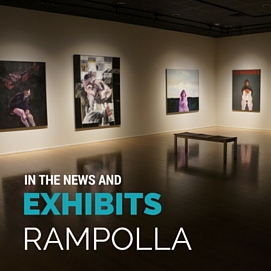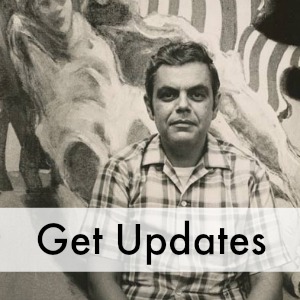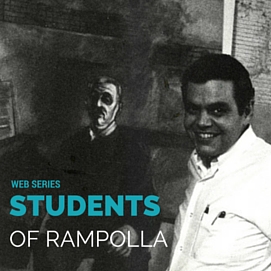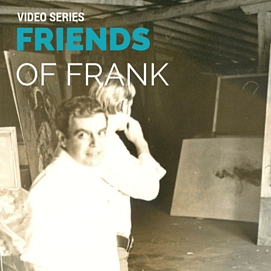Fred Stephen Licht
July, 1965
(Licht is known as an spell-binding art historian and author. He lectured at Princeton University and was professor at Williams College and Boston University. Below are the comments that Fred Licht made about Frank Rampolla’s work when Rampolla was the first living artist to have a one man show at The Ringling Museum of Art, Sarasota, Florida in 1965. )
In the last fifty years or so it has become increasingly unfashionable for an artist to have a sense of his own genealogy. Critics have intended to introduce artists as if they had begun their career with no baggage but the will to create images. This tendency is understandable when one considers the tremendous pressures of academic tradition against which the true artists of our century have had to assert themselves. It is only natural that painters, struggling for freedom from outmoded and hypocritical contents and forms should have insisted on starting out afresh. And certainly no one would deny the great advances, discoveries and benefits that accrue to us today because of their struggle.
The battle fought by the immediate predecessors of our era, the battle fought by Picasso, Mondrian, Klee, Duchamp, paved the way for the clamorous acclaim harvested by the American avant-garde during the late forties and fifties. We are now witnessing the last expression of this victory: a slightly insolent and extremely witty form of Dada-made-chic. Pop-art, neo-Dada, call it what you will, is the latest and most luxuriant, most relaxed fruit of the victory which was won by the strenuous engagement of such artists as Gorky, deKooning, Pollock and Rothko.
But for those artists who are growing into full maturity just now and who know comparatively little of the exuberance and excitement and success of the immediate post-war period (a period determined to turn its back on the slogans, the muscle and the sweat of the war, goes a far way in explaining the humorous, charming urbanity of Rauschenberg or Johns)—for these new artists, a new aspiration and a new commitment are more and more necessary. Rampolla belongs to this new generation which is only just beginning to make a very quiet appearance on the turbulent art scene of our day.
Rampolla, unlike his predecessors, is aware of his breeding, of his artistic genealogy. To a certain extent, of course, every artist has to make his own beginnings. But the radical rejection of antecedents, the haughty insistence on the exclusive importance of the artist’s self, is no longer echoed in Rampolla’s work. Kurt Schwitters once said: “When an artist spits, it is art.” And many of the artists who beginnings lie in the thirties and early forties would agree to a greater or lesser degree with Schwitters’ dictum. Nor is Schwitters to be considered an unduly arrogant creature. For a certain type of artist or for an artist in a certain historical and social situation, Schwitters’ verdict is perfectly justified. But to an artist like Rampolla, who childhood was spent during the Depression, whose early adolescence was shadowed by the war and whose first youth took him through the riotous, contradictory years of the post-war period during which the ideals of the thirties and forties were either forgotten or else trampled in the most audacious way—to such an artist the exalted assertion of Schwitters will be nothing but the puzzling expression of a golden age in which the artist felt himself to be the only hero left in an emasculated civilization.
The localization in time and spirit of Rampolla may be considered irrelevant to many of his admirers. His art is so authoritative, his brushwork, his composition, his transmission of his vision of things through the perfect coloristic equivalent is so precise that one might well spend one’s time discussing the full mastery of his work by pointing to particularly happy formal, expressive or coloristic solutions. Much, for instance, could be said about his brush-stroke, which functions simultaneously as linear definition of form, as vector of energy, as part of a web of surface planes and as autonomous color-shape. But the interested public of today has received what probably amounts to the most thorough training in pictorial, formal and technical analysis that any public has ever enjoyed and will be able to savor for itself the blend of refinement and strength. Rampolla goes beyond the esthetic demands of his art. He has seen fit to devote himself to an idea and he doesn’t shrink from the responsibility of also devoting his paintings to this idea. He sees himself not only as one point in the trajectory of modern art, he also sees himself as the temporary end-product of human development. He has chosen to draw his sustenance not only from the esthetic condition of mankind at a given moment of civilization but also from the human condition. Much of the most viable art of our decade is at least partly based on polemical critical dialogue among painters. It isn’t just that action-painting (to name on instance) is superseded by another art. This would be normal. Instead it is argued against, parodied, criticized and aggressively “shown up.” Never before have artist and critic become so closely identified with one another. For the artist has assumed the function of the critic and his paintings are often just as important for the things they say against the art of the last season as they are for what they say for the future. Rampolla has no concern with challenging previous esthetic positions. His entire energy goes into consolidating his own points of vantage.
During his travels abroad (especially in his ancestral Italy), Rampolla found himself drawn to the religious art of past epochs. No wonder! For Rampolla is an artist whose work is eminently public in its direction as is the art of all the major figures of Italian religious painting. Cimabue, Giotto, Masaccio, Piero della Francesca, the great Venetians of the Renaissance, Caravaggio and his descendants, all made of their art a hinge which mediated between the human condition of their time and the great moral religious concepts to which their epochs aspired. It is certainly necessary and it is certainly fruitful to admire the work of these artists for their enduring esthetic forcefulness. But ordinarily created for the sophisticated enjoyment of a restricted elite but for the purpose of letting an enormous public share in the religious, ethical and emotional speculations of the artist. Mostly of architectural dimension and of architectural permanence, these paintings are not cabinet pieces designed to delight the initiated. It is this spirit and this will to find painterly formulations for a deep personal but communicable experience which is quite organically link Rampolla with his ancestors.
If one coordinate of Rampolla’s art leads us into his ancestry, another coordinate is anchored securely in the here and now. Rampolla is just as true to his present and to his future as he is to his past: his work is intensely concerned with an emotional range and with a moral awareness which grow directly out of the major problems (both esthetic and spiritual) faced by other responsible artists in America today. Each age has its peculiar tenor of brutality and its peculiar mourning in response to this brutality. The surrounding galleries of the Ringling Museum, where this exhibition has its first showing, are filled with 17th-century conceptions of martyrdom and death expressed in the idiom of that time. A comparison with these will quickly establish the modernity of Rampolla’s emotional fibre. In all Baroque suffering there is an appeal to divine compassion and suffering is understood to be a temporary state which leads to ultimate salvation. In Rampolla’s vision of human destiny, barbarity is final and only consolation that redeems pain is the militant compassion it can arouse in those who witness it and are stirred to outrage.
Rampolla challenges us to reconsider our positions by deliberately choosing themes which have already been treated in familiar master pieces. Rembrandt’s great Slaughtered Ox, for instance, has inspired him to create variants. But the mysterious calm which invests Rembrandt’s painting has disappeared from Rampolla’s versions. Gone is the mild light; gone, too, is the little figure of the butcher’s maid silently, humbly doing her work. In Rampolla’s painting we are introduced to the theme of death with an intransigeant immediacy. Deterioration, the falling apart of what once had a unique, energetic and organic shape is the dominant theme and with great impartiality Rampolla shows us both the smoldering beauty of reds (subsiding from pink or quick scarlet to the deepest, most opaque of crimsons) and the instinctive horror of all rotting things. All the varied stages of extinction, all the equally varied responses to the inescapable vestiges of death are given their full pictorial transcription in this picture and in Rampolla’s earlier etched variant.
Because of their immediacy, Rampolla’s painting are paradoxically inaccessible since we often automatically blind ourselves to those realities which we would rather not see exposed. There is a rawness here which makes us feel raw and skinned. The phosphorescent scale of whites he uses (reminiscent of the whites of embryos pickled in alcohol) conveys to us the feeling of laceration, of having tender flesh and glistening tendons laid bare. It is far easier to contemplate the esthetically contrived rawness of Pop-art which is perceived only after an academic analysis of the image has preceded our recognition of the artists intent. Rampolla minimizes the speculative, intellectual distance between us and the picture. Though he usually relies on the figure, he is, in this respect at least, far less academic than many of our contemporary avant-garde artists. There is a brooding resonance in all his paintings (even those of cheerful subjects) which plunges us into an awareness of human tragedy without the intercession of surrealist psychology or fanciful digressions about the nature of perception and the nature reality.
Ultimately, however, an artist says what he has to say by means of the elements he has at his disposal: color, line, spatial devices, tension or balance of volumes or planimetric shapes. To find (or invent) proportions and relationships which are precisely adequate for his purpose, is his primary concern.
In his compositions Rampolla distinguishes himself by striking out for a perspective space that is not determined by a conventional vanishing-point but rather by the assertion of the figures against their linear and luminous environment. Space for him is not an independent void but a dark and massive medium which is forcibly displaced by the figure. The oppressive force of this space is not only a formal construction but a vehicle which conveys to us the sense of incubus which surrounds his figures.
Another problem that faces Rampolla is the compositional relationship of the figures themselves. Their tense isolation must be expressed without destroying the organic and optic logic of the total image. By means of very subtle and sometimes ambiguous forms or lights, which condense and coagulate from the surrounding atmosphere, Rampolla establishes a scaffolding which integrates the figures with the ground-plane and with one another without sacrificing the dynamic, constantly shifting equilibrium of these pictorial elements. Here again, form and content are so fused that the one immediately suggests the other. Menaced equilibrium, disintegration of the superficial structures, the tension of eccentrically counterpoised forms—all these are thematic ideas at the same time that they are compositional devices.
The color, too, follows this pattern. Its beauty is not based on harmony or pleasure. Instead, its beauty arises from a logical and expressive necessity in which one color summons up the next in order to bring the first color to its highest pitch of intensity. What appears sometimes to be dissonant when judged by external standards of color-theory turns out to be harmonious when regarded in the context of the picture’s total impact. Thus a livid pink set against a dull scarlet may seem discordant by itself but will find its justification in the further context of the picture as a whole. Few of Rampolla’s paintings are attractive in the familiar sense of the word. But what keeps one’s eye on them long after the first shock has worn off is their unquestionable authority, the way he has resolved form, color and content into an indissoluble vision which is persuasive because it has been deeply experienced.
Every painter is bound to run serious risks. Portentousness and melodramatic balefulness are Rampolla’s greatest internal enemies. The foreboding mood, the Spanish gloom can all too easily slip into facile Grand Guignol effects. For this there is only one known remedy: perpetual vigilance over the truth and depth of his vision. The artist must be ready to sacrifice all those elements of sentiment which are inspired by ephemeral moods or by too limited personal sentiment. Personal experience is irrelevant unless the artist can render the event so transparent that all the momentary confusions disapear and we become aware of a significantly novel human relevation. The individual apprehension of any physical or emotional reality or of any event is only a starting point. It is the bridgehead which allows the gifted artist to cross the chasm that divides each of us from the other. And it happens too often that the artist illudes himself and that what he has treated as a universal experience turns out to be strictly particularized.
The risk is serious and Rampolla, who destroys more pictures than he completes, must be aware of it. He judges his paintings at various stages of progress as if his canvases were autonomous existences independent of himself, things to be judged without indulgence, on their own merit. And if one looks at his paintings closely one will notice how spontaneity of touch and of color is always coupled with severe self-control.
But these are only ambiguous impressions and reflections. The individuality of an artist’s style can be hinted at obliquely but never fully described. This limitation becomes even more discouraging when the artist has just begun to build on the recognition of his own ambitions and of his own identity. But both the coherence and the diversity of the works in this exhibition clearly indicate that a new artistic personality has been coined, very fresh and clear in its outlines, and the quality of the coinage is such as to make us believe that it will find wide currency.




